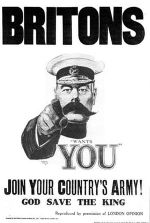The infantry
Lord Kitchener issued an order for the enlistment of the New Army's first 100,000 men on August 31st, 1914.
This first one hundred thousand (K1) were to be assigned to the first six New Army divisions. This was achieved by September
12th and plans were made for the second hundred thousand (K2) which would make up the 12th to 20th Divisions. Service battalions
were formed and incorporated into Regular Army regiments where it was hoped that they would inherit the old 'esprit de corps'
of the historic regiments.
The men of the 17th Division were mostly from the north of England. 13 of the 14 battalions were raised in Yorkshire
and Lancashire which resulted in the official designation of the 17th Northern Division. The odd man out was the 6th (Service)
Battalion of the Dorsetshire Regiment. This battalion was formed at the barracks in Dorchester, close to where the Division
was trained.
In true army logic, the 17th Northern Division was sent to the southern county of Dorset in the last days of September.
Divisional headquarters was set up in the small town of Wareham. The early days were beset with problems, Wareham was too
small to billet thousands of men so camps were set up on the heathlands around the town. The 7th York and Lancasters left
Pontefract in two trains, the first arrived in Wareham but the second arrived on a wet evening in the small village of Wool
near Bovington. The men detrained in the pouring rain and spent a miserable night in the open before finally reaching Wareham
the following morning. The local population did all that they could for the bedraggled men. A member of the battalion penned
these lines.
"Here's just a line as a message of thanks
For the way you have treated the Yorks and the Lancs;
Because, till you're wet through, there's nobody knows
The pleasure of wearing a dry suit of clothes."
"Your kindness we'll speak of wherever we roam,
And our wives and our mothers will bless you at home,
So please take our thanks, and your townpeople share'em,
The Yorks and Lancs. bless the people of Wareham.
The 6th Dorsets set up camp at Worgret, a mile from Wareham and were accommodated in tents with up to twelve
men. November came and with it gales and heavy rain. The men of the Division had a miserable time as tents were blown away,or
at best sprung leaks. Within time, camps with new hutments were set up but not before many men were lost to illness due to
their time in the rainsoaked camps.
Training, however, continued. Trenches were dug in the shadow of the Purbeck hills and old pattern Lee Enfield
rifles arrived in December. Leave was granted to many during the Christmas period with full training resuming in mid January.
Musketry was taught on the newly built range at Hyde Heath near Bovington.
Major General Kenyon Slaney resigned his command and handed over the Division to Major General T.D. Pilcher
C.B. who lectured the officers on trench warfare in the cinema at Wareham.
On May 27th, 1915, orders arrived for the Division to move to Romsey in Hampshire. The inhabitants of Wareham
came out to watch the 17th Northern Division march out to the music of the 6th Dorsets' band.
They were now ready for the Western Front.


